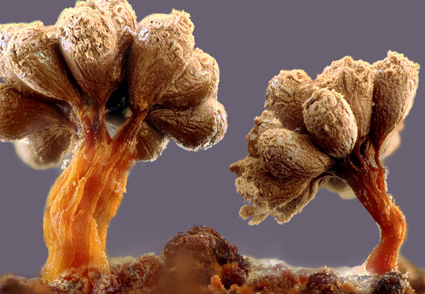Abstract
The examination of new collections of Alwisia repens and the isotypes of A. repens and A. morula has revealed that these species exhibit a vestigial capillitium in the form of smooth tubules. These tubules are either directed downward or embedded parallel to the peridium; in A. morula they may be long enough to extend from the top to the base of the sporotheca. In both species the upper part of the peridium dehisces into polygonal platelets, which are delimited by preformed fissures. This type of sporotheca opening has not been documented in the Reticulariales before and is known to occur only in certain species within Echinosteliales, Liceales and Trichiales. Newly obtained specimens of A. repens display well-developed, erect stalks. This contradicts the original diagnosis which describes the species as having creeping stalks. We propose emended descriptions for A. repens and A. morula to incorporate these newly discovered characteristics.
References
- Bortnikov, F.M., Bortnikova, N.A., Gmoshinskiy, V.I., Prikhodko, I.S. & Novozhilov, Y.K. (2023) Additions to Trichia botrytis complex (Myxomycetes): 9 new species. Botanica Pacifica 12 (2): 1–39. https://doi.org/10.17581/bp.2023.12s03
- Byrne, M., Steane, D.A., Joseph, L., Yeates, D.K., Jordan, G.J., Crayn, D., Aplin, K., Cantrill, D.J., Cook, L.G., Crisp, M.D., Keogh, J.S., Melville, J., Moritz, C., Porch, N., Sniderman, J.M.K., Sunnucks, P. & Weston, P.H. (2011) Decline of a biome: evolution, contraction, fragmentation, extinction and invasion of the Australian mesic zone biota. Journal of Biogeography 38: 1635–1656. https://doi.org/10.1111/j.1365-2699.2011.02535.x
- Leontyev, D., Buttgereit, M., Kochergina, A., Shchepin, O. & Schnittler, M. (2023a) Two independent genetic markers support separation of the myxomycete Lycogala epidendrum into numerous biological species. Mycologia 114(6), 1–12. https://doi.org/10.1080/00275514.2022.2133526
- Leontyev, D., Ishchenko, Y. & Schnittler, M. (2023b) Fifteen new species from the genus Lycogala (Myxomycetes). Mycologia 115 (4): 524–560. https://doi.org/10.1080/00275514.2023.2199109
- Leontyev, D. & Schnittler, M. (2021) Phylogeny and phylogenetically based classification of Myxomycetes. In: The Myxomycetes: Biology, Systematics, Biogeography and Ecology; 2nd ed. Elsevier Academic Press, pp. 97−124. https://doi.org/10.1016/B978-0-12-824281-0.00008-7
- Leontyev, D., Schnittler, M., Ishchenko, Y., Quade, A., Kahlert, H., Rojas Alvarado, C. & Stephenson, S.L. (2022) Another species complex in myxomycetes: diversity of peridial structures in Lycogala epidendrum. Nova Hedwigia 114 (3–4): 413–434. https://doi.org/10.1127/nova_hedwigia/2022/0690
- Leontyev, D., Schnittler, M., Moreno Horcajada, G., Stephenson, S., Mitchell, D.W. & Rojas, C. (2014a) The genus Alwisia (Myxomycetes) revalidated, with two species new to science. Mycologia 106 (5): 936–948. https://doi.org/10.3852/13-314
- Leontyev, D., Schnittler, M. & Stephenson, S.L. (2014b) A new species of Alwisia (Myxomycetes) from New South Wales and Tasmania. Mycologia 106 (6): 1212–1219. https://doi.org/10.3852/14-075
- Leontyev, D., Schnittler, M. & Stephenson, S.L. (2014c) Pseudocapillitium or true capillitium? A study of capillitial structures in Alwisia bombarda (Myxomycetes). Nova Hedwigia 99 (3–4): 441–451. https://doi.org/10/1127/0029-5035/2014/0209
- Leontyev, D., Schnittler, M. & Stephenson, S.L. (2015) A critical revision of the Tubifera ferruginosa complex. Mycologia 107 (5): 959–985. https://doi.org/10.3852/14-271
- Leontyev, D., Schnittler, M., Stephenson, S. & Novozhilov, Y.K. (2019a) Systematic revision of the Tubifera casparyi/T. dictyoderma complex: Resurrection of the genus Siphoptychium and introduction of the new genus Thecotubifera. Mycologia 111 (6): 981–997. https://doi.org/10.1080/00275514.2019.1660842
- Leontyev, D., Schnittler, M., Stephenson, S., Novozhilov, Y.K. & Shchepin, O.V. (2019b) Towards a phylogenetic classification of Myxomycetes. Phytotaxa 399 (3): 209–238. https://doi.org/10.11646/phytotaxa.399.3.5
- Lloyd, S.J., Leontyev, D. & Dagamac, N.H. (2019) Three new species of Tubifera from Tasmania and New South Wales. Phytotaxa 414 (5): 240–252. https://doi.org/10.11646/phytotaxa.414.5.2
- Lloyd, S.J., Leontyev, D., Moreno, G., López Villalba, A. & Schnittler, M. (2023) Tasmaniomyxa umbilicata, a new genus and new species of myxomycete. Mycologia 115 (6). https://doi.org/10.1080/00275514.2023.2274252
- Martin, G.W. (1961) Taxonomic notes on Myxomycetes III. Brittonia 13: 109–113. https://doi.org/10.2307/2805288
- Poulain, M., Meyer, M. & Bozonnet, J. (2011) Les Myxomycètes. Féd Mycol Bot Dauphiné-Savoie, Delémont, 556 pp.
- Rojas, C. & Stephenson, S.L. (eds.) (2021) Myxomycetes. Biology, Systematics, Biogeography and Ecology. Elsevier: Academic press. https://doi.org/10.1016/C2020-0-01675-0
- Schnittler, M., Stephenson, S.L. & Novozhilov, Y.K. (2000) Ultrastructure of Barbeyella minutissima (Myxomycetes). Karstenia 40: 159–166. https://doi.org/10.29203/ka.2000.367
- Shadwick, J. & Cooper, J. (2018) Planetary biodiversity inventory eumycetozoan databank. Occurrence dataset, hosted by University of Arkansas. [accessed via GBIF.org on 21 November 2023] https://doi.org/10.15468/zxmhsy


